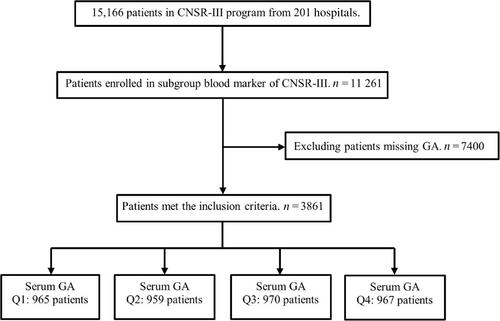Glycated albumin levels are associated with adverse stroke outcomes in patients with acute ischemic stroke in China
Abstract
Background and Aim
Glycated albumin (GA) is a biomarker monitoring glycemia 2–4 weeks before stroke onset. This study was designed to explore the association between GA levels with poststroke outcomes in patients with acute ischemic stroke or transient ischemic attack (TIA).
Method
Participants with ischemic stroke or TIA who had a baseline GA measurement were included in the Third China National Stroke Registry study. The effect of GA on stroke recurrence, poor functional outcomes, and combined vascular events was examined during the 1-year follow-up period. Multivariate Cox and logistic regression models were performed to evaluate the association. Discrimination tests were used to examine the incremental predictive value of GA when incorporating it into the conventional model.
Results
A total of 3861 participants were enrolled. At the 3-month follow-up, the elevated GA level was associated with an increased risk of poor functional outcomes (adjusted odds ratio [OR], 1.45; 95% confidence interval [CI], 1.01–2.09). A similar increase was observed for stroke recurrence (adjusted hazard ratio [HR], 1.56; 95% CI, 1.09–2.24), poor functional outcomes (adjusted OR, 1.62; 95% CI, 1.07–2.45), and combined vascular events (adjusted HR, 1.55; 95% CI, 1.09–2.20) at the 1-year follow-up. In nondiabetic patients, the association between GA and poor functional outcomes was more pronounced (adjusted OR, 1.62; 95% CI, 1.05–2.50). Adding GA into the conventional model resulted in slight improvements in predicting poor functional outcomes (net reclassification improvement [NRI]: 12.30% at 1 year).
Conclusion
This study demonstrated that elevated GA levels in serum were associated with stroke adverse outcomes, including stroke recurrence, poor functional outcomes, and combined vascular events, in patients with ischemic stroke or TIA.


 求助内容:
求助内容: 应助结果提醒方式:
应助结果提醒方式:


